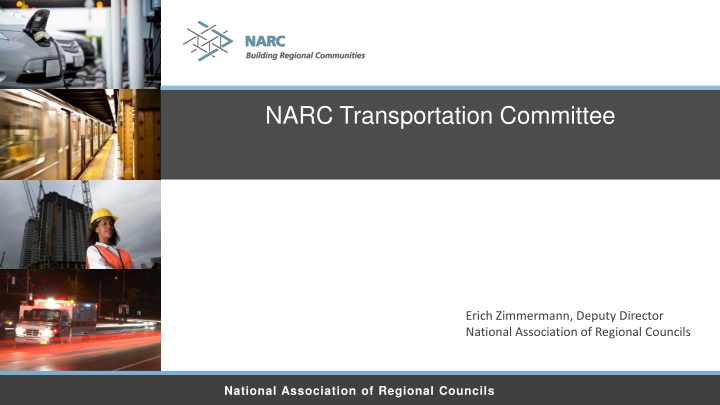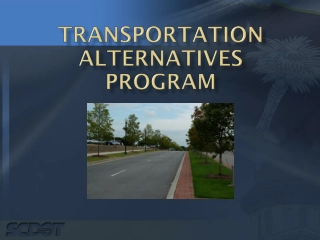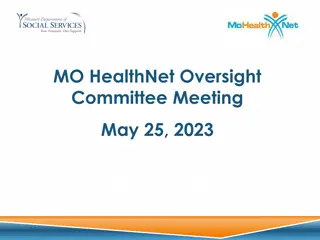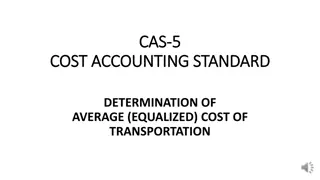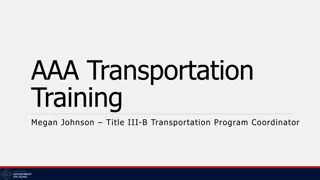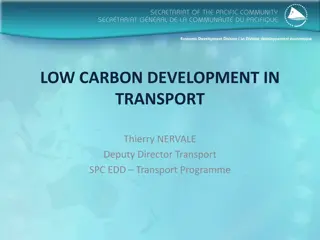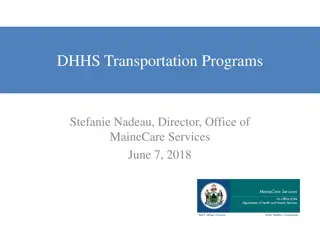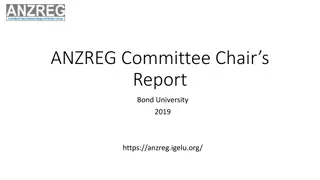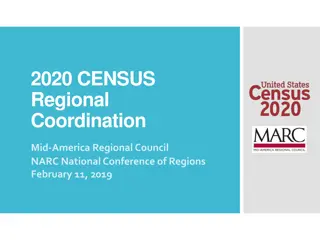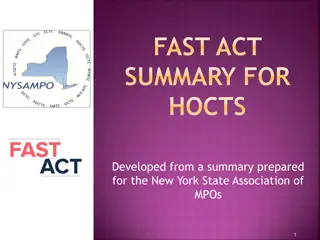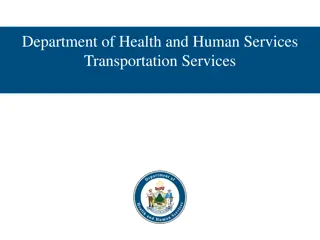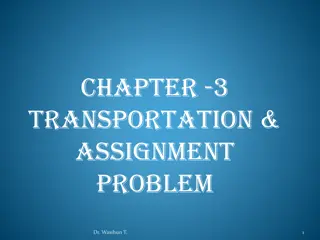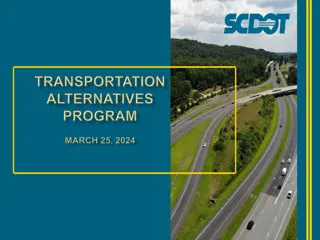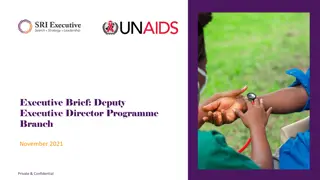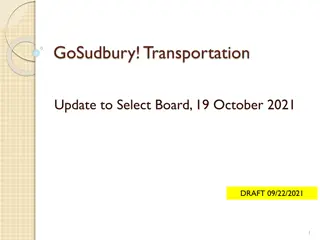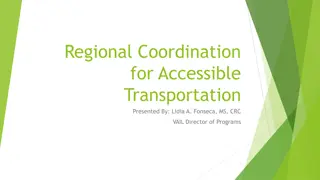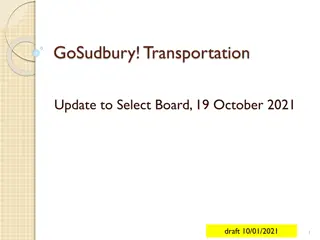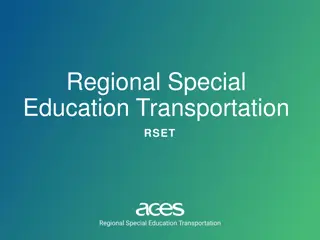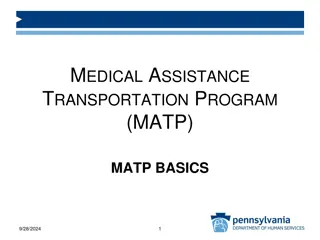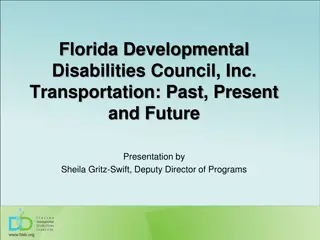NARC Transportation Committee Erich Zimmermann, Deputy Director
Transportation Policies and Priorities focus on funding, planning, resilience, and safety measures to enhance regional transportation systems. The National Association of Regional Councils emphasizes transparent decision-making, flexible planning, and expanded project eligibility to address current challenges and emerging opportunities in the transportation sector.
Download Presentation

Please find below an Image/Link to download the presentation.
The content on the website is provided AS IS for your information and personal use only. It may not be sold, licensed, or shared on other websites without obtaining consent from the author.If you encounter any issues during the download, it is possible that the publisher has removed the file from their server.
You are allowed to download the files provided on this website for personal or commercial use, subject to the condition that they are used lawfully. All files are the property of their respective owners.
The content on the website is provided AS IS for your information and personal use only. It may not be sold, licensed, or shared on other websites without obtaining consent from the author.
E N D
Presentation Transcript
NARC Transportation Committee Erich Zimmermann, Deputy Director National Association of Regional Councils National Association of Regional Councils
Transportation Policies and Priorities Last Updated: June 2018 Reauthorization Principles: approved mid-2019 -some synthesis between the two was needed Held call with committee members, put call out for edits/suggestions Primarily reorganization, reauthorization elements -a few truly new ideas Will be approved by EDC, Board National Association of Regional Councils
Transportation Policies and Priorities Funding and Financing Prohibit funding decisions based on the share of funding a local sponsor can provide. Institute reforms to require more transparent decision-making in the process of choosing grant recipients. Ensure state rules and requirements do not reduce or limit efficient expenditure of federal transportation funding, including planning funding. National Association of Regional Councils
Transportation Policies and Priorities Planning Update the regional planning process to make it more responsive to current and emerging opportunities and challenges, including technology, data, and resilience. Provide MPOs and RTPOs with authority, data, and funding to meet these challenges within their communities. Provide flexibility in determining MPO boundaries and the make-up and structure of MPO policy boards. Add non-traditional and emerging technologies to the list of eligible project types under the STBGP, to ensure they are considered during the regional prioritization process. Integrate resilience as a core consideration in planning and project prioritization. Provide funding and authority for planning and implementation of projects to increase system resilience, including making drainage projects to reduce flooding an eligible expense. Increase coordination of federal approaches to resilience across agencies. Support efforts to allow for greater consideration of housing and land use in the planning and project prioritization process. National Association of Regional Councils
Transportation Policies and Priorities Goods Movement Suballocate National Highway Freight Program (NHFP) funding to MPOs and ensure regional councils are explicitly eligible to utilize any new dedicated freight funding sources. Safety Expand opportunities for regional councils to ensure the safety of all system users. Suballocate Highway Safety Improvement Program (HSIP) funding to MPOs and RTPOs for local prioritization. Expand project eligibility to ensure non-driving modes are better protected, including planning and projects for Vision Zero. National Association of Regional Councils
Transportation Policies and Priorities Technology and Data Provide authority and funding to prepare regions and local governments for connected and automated vehicles and related infrastructure. Provide federal assistance with data on access to jobs and educational opportunities to ensure more equitable and efficient project prioritization. Continue to provide federal data sources to support regional and local planning. Ensure regional organizations, local governments, and public transportation agencies have free access to data especially safety data and vehicle data collected by vehicle manufacturers and wireless communication carriers to improve planning and maximize public benefit. Encourage and enable data sharing between all levels of government. Empower local governments to enact policies about emerging technologies, including automated vehicles. Do not preempt local authority, to ensure policies are consistent with local mobility goals. National Association of Regional Councils
Transportation Policies and Priorities Implementation and Rulemaking Maintain the autonomy of MPOs and consider the importance of locally- defined policies and priorities. National Association of Regional Councils
Transportation Reauthorization CBO: 10-year deficit: $188B!! National Association of Regional Councils
Transportation Reauthorization Senate $287B in funding 5 years Highway title only House $760B in funding 5 years Highways/transit/rail/airports/ harbors/inland waterways/ clean and wastewater/ brownfields/broadband/ schools? No funding source identified No funding source identified National Association of Regional Councils
Transportation Reauthorization Senate No major changes to the structure or function of the program Climate title, resilience, bike/ped safety wildlife crossings Notable addition of several new programs/pilot projects House Fundamental reconsideration of the program Climate title, resilience, bike/ped safety, wildlife crossings Framework, not a bill National Association of Regional Councils
Transportation Reauthorization Transportation and Infrastructure Committee Highway and Transit Programs $434B Transformative Highway Investments $319B Transformative Transit Investments $105B Transformative Safety Investments $10B Transformative Rail Investments $55B Transformative Airport Investments $30B Harbor Maintenance Trust Fund $19.7B National Association of Regional Councils
Transportation Reauthorization Transportation and Infrastructure Committee (cont.) Water Resources $10B Transformative Water Resources Investments $7B Transformative Inland Waterways Investments $3B Clean Water $50.5B Transformative Water Investments $47.1B Clean Water State Revolving Funding Investment $40B State Clean Water Compliance Assistance $1.5B Clean Water Act Grant Program Investments $5.6B Transformative Regional Investments $3.4B National Association of Regional Councils
Transportation Reauthorization Transportation and Infrastructure and Energy and Commerce Committees (joint jurisdiction) Brownfields Restoration and Reinvestment $2.7B Energy and Commerce Committee Clean Drinking Water and Clean Energy $59.7B Transformative Drinking Water Investments $25.4B Transformative Clean Energy Investments $34.3B Broadband and Communications $98B Transformative Broadband Investments $86B Public Safety Communications Investments $12B National Association of Regional Councils
Transportation Reauthorization Brings Infrastructure up to State of Good Repair and Delivers Critical Projects Investment in Major Projects Provides funding for vital infrastructure projects of regional and national significance, with focused eligibility criteria and reduced Secretarial discretion over project selection. Investment in Bridges Provides funding to repair or replace bridges in poor condition, including in rural areas. Investment in Communities Provides targeted funding for communities, tribes, and rural and other continually disadvantaged areas. Simplifies Project Financing Options Continues funding for the TIFIA program while streamlining the application process and increasing transparency in the vetting process for projects seeking TIFIA funds. National Association of Regional Councils
Transportation Reauthorization Reduces Dependence on Fossil Fuels and Curtails Carbon Pollution Investment in Alternative Fuel Infrastructure Provides opportunities and funding to States, MPOs, and local governments to build fueling infrastructure for zero pollution hydrogen and electric vehicles along designated highway corridors. Investment in Carbon Pollution Reduction Incentivizes projects to reduce carbon pollution from the transportation sector, including freight, and promotes cleaner communities around transportation facilities. Focuses on cutting congestion and related pollution, including through the use of technology in urban areas. National Association of Regional Councils
Transportation Reauthorization Boosts Resilience Strengthens Transportation Facilities Creates a new program to protect fragile or at-risk transportation assets before they fail, to invest in evacuation routes, and to increase resiliency to climate change and other natural disasters, including earthquakes. Revamps Existing Formula Programs Amends core highway formula programs to prioritize investments and improve program implementation: Fix it First Prioritizes maintaining and improving existing infrastructure and bringing it up to a state of good repair, including roads, bridges, tunnels, and ferry systems. Performance-Based Investments Ensures current performance measures have teeth and holds States accountable to achieve improvements. Advances project planning and design approaches that result in efficient, effective, and sustainable transportation decisions, including through practical design. National Association of Regional Councils
Transportation Reauthorization Revamps Existing Formula Programs (cont.) Resilient Infrastructure Ensures that resiliency is a decision-making factor in the Federal highway planning and project selection process, with an emphasis on life-cycle and long-term asset performance. Modifies the Emergency Relief program to ensure facilities can be rebuilt better and stronger. Reduces Pollution Requires States to measure greenhouse gas pollution; focuses States and MPOs on developing policies and making investments that will reduce transportation-sector pollution; supports innovative construction materials to reduce our carbon footprint; reforms the Congestion Mitigation Air Quality program to prioritize clean, zero pollution options; and boosts investment in cycling, walking, and public transportation, including ferries. Targets Highway Safety Modifies the Highway Safety Improvement Program to focus on safety improvements that address the greatest safety risks, including improving pedestrian and cyclist safety; addressing hazards on high-risk rural roads; improving work-zone safety; and providing children safe routes to school. Requires States and MPOs to use Complete Streets standards and policies; supports the implementation of Vision Zero goals; and expands innovative solutions to improve highway-railroad grade crossing safety and congestion. National Association of Regional Councils
Transportation Reauthorization Revamps Existing Formula Programs (cont.) Empowers Local and Tribal Governments Authorizes technical assistance to cities, counties, rural areas, and tribes to improve capacity to receive and administer Federal funds and facilitate project delivery. Ensures that State DOT practices to exchange or swap Federal transportation funds for State dollars do not undermine labor protections. Expands Local Control Expands decision-making over Federal funds to other levels of government and provides additional authority to metropolitan planning organizations that demonstrate the capacity to administer Federal funds. Amends the suballocation process to ensure mid-sized communities receive a portion of program funds. Tackles Congestion Equitably Institutes tighter standards around tolling and congestion pricing. Modernizes Project Planning Requires States and MPOs to prioritize transportation access and to consider during the planning process all system users, job access, connections to housing, and creation of transportation options in underserved communities. National Association of Regional Councils
Transportation Reauthorization National Association of Regional Councils
Transportation Reauthorization Why not? Widely divergent policy approaches Challenging pay-for situation Deeply partisan environment Election year politicking HTF has funding through first half of 2021 Why? Give me something to campaign on If it goes It ll go fast, it ll be fully baked, and it ll likely require the WH to play a significant role National Association of Regional Councils
NEPA Changes CEQ Notice of Proposed Rulemaking National Environmental Policy Act (NEPA) Second substantive change to NEPA regulations in 40 years Docket number: CEQ-2019-0003-0001 Comments due: March 10, 2020 Public hearing in DC on February 25, 2020 National Association of Regional Councils
NEPA Changes 1. Streamlines effects analysis a. Removes terms direct indirect cumulative impacts b. EIS should evaluate effects that are reasonably foreseeable and have a close causal relationship c. Eliminates effects analysis based on but for causation, that are remote in time or geography, that the agency cannot prevent, and that are cumulative i. Last part is what is causing heartburn about climate impacts analysis 2. Allows project applicants to assist in the preparation of NEPA documents, under federal supervision. a. Defining purpose and need b. Preparing the EIS National Association of Regional Councils
NEPA Changes 3. Changes the threshold at which NEPA review is triggered a. Reconsideration of "major federal action." b. The following would no longer require NEPA review: i. projects with minimal federal funding or involvement ( minimal is not defined); i. CEQ Asking whether percentages or dollar amount are appropriate ii. Non-discretionary decisions or decisions or activities that do not result in final agency action; iii. projects in which the federal action is limited to loans or financial assistance where the agency doesn't have control or responsibility for the effects of an action. c. CEQ is also asking whether there are government-wide CEs that would be appropriate. National Association of Regional Councils
NEPA Changes 4. Narrows definition of reasonable alternatives an EIS must evaluate 5. Codifies One Federal Decision policy, requiring joint schedules, a single record of decision, and a single impact statement required when multiple agencies are involved 6. Expands pre-scoping 7. Changes to judicial review a. NEPA violations would not warrant halting a project b. Limiting judicial relief to issues that were specifically raised during the public comment phase. 8. Limits on the time (2 years for EIS, 1 year for EA) and number of pages allowed (150 pages for EIS or 300 for projects of unusual scope or complexity, 75 pages for EA) in NEPA documents. National Association of Regional Councils
Legislation and Rulemaking Unobligated Balances Housing/transportation HR 4307 Build More Housing Near Transit Act HR 5255 More TOD Act Differential Privacy Census Issue AV 4.0 & AV Legislation DOT-OST-2019-0179, April 2, 2020 5.9gHz FCC 19-129 LOT Letter National Association of Regional Councils
